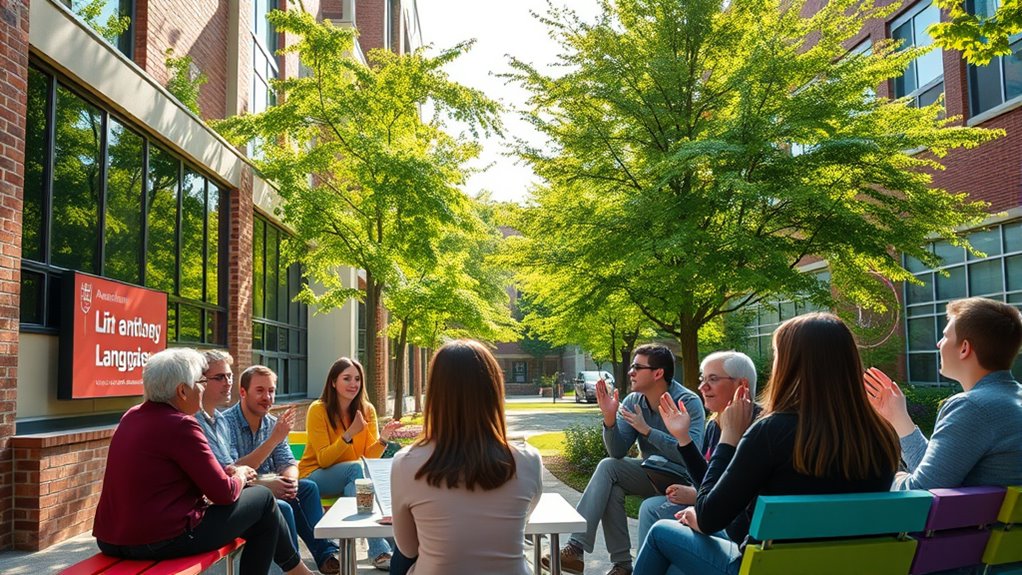Many study abroad programs welcome deaf students by offering sign language immersion, accessible accommodations, and strong support services. These programs provide opportunities to connect with deaf communities, practice sign language, and explore new cultures confidently. Look for programs that prioritize accessibility and facilitate social and academic engagement. If you explore options carefully, you’ll find inclusive opportunities tailored to your needs. Continuing further, you’ll discover how to choose the best program for your goals and preferences.
Key Takeaways
- Look for programs that explicitly advertise accessibility services like interpreters, captioning, and visual alert systems.
- Prioritize programs with strong connections to local deaf communities and sign language immersion opportunities.
- Choose programs with clear policies on accommodations and proactive support for deaf students.
- Seek out programs offering community engagement activities, clubs, and events for deaf students.
- Research institutions that specialize in inclusive education and have a track record of supporting deaf international students.

Studying abroad offers deaf students unique opportunities to expand their academic and cultural horizons, but maneuvering these programs can present specific challenges. One of the most enriching aspects of studying abroad is the chance to immerse yourself in a new culture and language, which can be especially meaningful if you have access to sign language immersion experiences. When choosing a program, look for options that emphasize opportunities to practice sign language in real-world settings, whether through community interactions, university classes, or social activities. This immersion helps you develop fluency and confidence while fostering genuine connections with local deaf communities.
Immersing in new cultures and sign language opportunities enhances fluency and connections abroad.
However, access to sign language immersion isn’t enough on its own; you’ll also want to guarantee that the program provides extensive accessibility accommodations. These accommodations might include qualified interpreters, captioning services, visual alert systems, or assistive technology tailored to your needs. When researching programs, don’t hesitate to ask detailed questions about the availability of these supports and how they are implemented. A well-designed program will prioritize accessibility and have procedures in place to address any barriers that may arise, making sure you can fully participate in academic, cultural, and social activities.
It’s vital to communicate your needs clearly during the application process. Many programs now recognize the importance of inclusivity and actively seek to accommodate deaf students, but policies vary widely. By providing detailed information about your required accommodations upfront, you give the program time to prepare and coordinate with service providers. This proactive approach minimizes potential disruptions and helps you focus on your learning experience rather than logistical concerns.
Beyond formal accommodations, consider the community aspect of the program. Look for opportunities to connect with other deaf students or local deaf residents, as these relationships can enrich your cultural understanding and provide emotional support. Participating in clubs, events, or volunteer activities within the deaf community can deepen your immersion and make your experience more meaningful.
Additionally, exploring programs that incorporate sign language education can further enhance your linguistic skills and cultural integration. Ultimately, choosing a study abroad program that values sign language immersion and accessibility accommodations ensures that you won’t just visit a new place—you’ll actively engage with it on your terms. By prioritizing these elements, you set the stage for a rewarding, inclusive experience that broadens your academic, cultural, and personal perspectives.
Frequently Asked Questions
Are There Specific Countries That Better Accommodate Deaf Students?
When considering countries that better accommodate deaf students, look for those with strong sign language policies and active efforts to promote Deaf community integration. Countries like the United States, Sweden, and New Zealand have robust policies supporting sign language and inclusive education. These nations foster environments where you can comfortably participate, connect with local Deaf communities, and access resources, making your study abroad experience more enriching and accessible.
How Do Deaf Students Access Emergency Services Abroad?
When accessing emergency services abroad, you should familiarize yourself with local emergency protocols and guarantee you have access to sign language resources. Carry a card with your emergency contact info and communicate your needs clearly. Use apps or services that offer sign language access, and learn key phrases in the local language for emergencies. Being prepared helps you navigate unfamiliar systems confidently and ensures you get the help you need quickly.
What Assistive Technologies Are Commonly Provided in These Programs?
You’ll find that many programs provide assistive technology and communication aids to support deaf students. These include devices like FM systems, sign language interpreters, captioning services, and visual alert systems. Such tools help facilitate effective communication and guarantee you can participate fully in academic and social activities. By offering these technologies, programs aim to create an inclusive environment where you feel comfortable and connected throughout your study abroad experience.
Do Programs Offer Sign Language Interpreters On-Site?
You’ll find that many programs do offer sign language services on-site to support deaf students. These services are often part of the program’s accommodation policies, ensuring you have equal access to classes and activities. It’s essential to check each program’s specific policies beforehand, so you can confirm that sign language interpreters are available when needed. This way, you can fully participate and enjoy your experience abroad.
How Do Cultural Differences Impact Communication for Deaf Students Abroad?
Imagine communication as a vibrant tapestry, woven with threads of cultural understanding. When you’re abroad as a deaf student, cultural differences can add new patterns and colors to this tapestry. Cultural communication styles and Deaf cultural awareness shape how you connect with others, sometimes making conversations feel like dancing to unfamiliar beats. Embracing these differences helps you navigate new environments with confidence, turning challenges into opportunities for growth and deeper understanding.
Conclusion
Beginning a study abroad journey is like opening a door to a world of new experiences and connections. As a deaf student, you can find programs that embrace your unique communication style and challenge you to grow. Don’t let barriers hold you back—think of these programs as bridges that connect you to diversity, understanding, and endless opportunities. Step through confidently, and let your adventure shape you into a global citizen.











